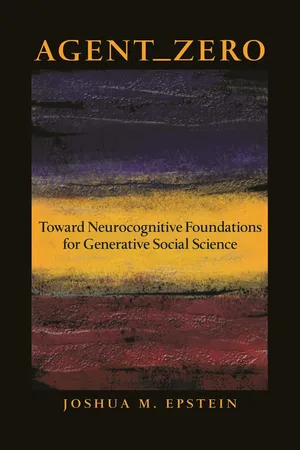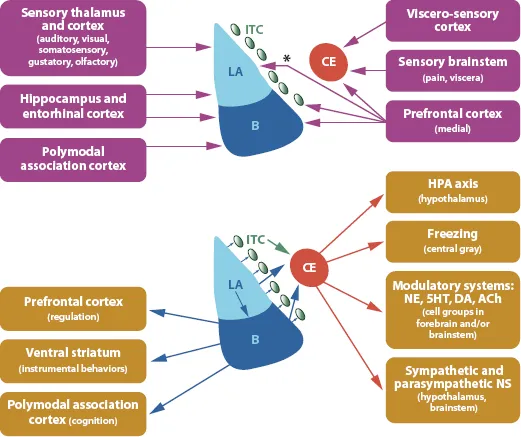![]()
PART I
Mathematical Model
IN THIS PART, we specify explicit mathematical models for the emotional, deliberative, and social components of the Agent_Zero framework. These choices are not cast in stone, and different components should certainly be explored, as discussed in the Future Research section. First, however, we review some underlying neuroscience of fear and its throne: the amygdala.39
This review is worthwhile because the Rescorla-Wagner equations (used for the affective model component) do not presuppose that fear acquisition is largely unconscious, while this is a crucially important fact from a social science standpoint, and the amygdala discussion demonstrates that it is a neuroscientifically sound modeling assumption. Also, important evidence of emotional contagion comes from fMRI studies of the amygdala, and if we didn’t know anything about the amygdala, these images would mean very little.
Understanding, then, that unconscious fear acquisition is what we have in mind, we now discuss the elementary neuroscience of fear as prelude to the famous Rescorla-Wagner equations of conditioning, all en route to our more general model of behavior in groups.
I.1. THE PASSIONS: FEAR CONDITIONING
Humans are born with a variety of innate endowments or capacities. One of these is the capacity to acquire fear (and other) associations through a process of synaptic change in which, as Donald Hebb (1949) presciently put it, “neurons that fire together wire together.” That is, after certain40 pairings of an initially neutral stimulus (e.g., a tone) and a stimulus that is innately aversive (e.g., a shock), the initially neutral stimulus will evoke the same response as the innately aversive stimulus. This associative process—often termed conditioning41—is generated by synaptic change, or “plasticity.” For a lucid nontechnical exposition, see LeDoux (2002). We, of course, cannot cut open a human and observe her fear, but we can intelligently speak of a fear circuit—a distributed neurochemical computational architecture42—whose proper functioning is of obvious evolutionary value and whose activation is strongly correlated with physical, autonomic, and other observable symptoms of fear (e.g., freezing). Indeed, LeDoux and others have mapped the fear circuit’s operation in considerable detail and have made huge strides in explaining the observed capacity for associative fear acquisition, retention, and extinction by Hebbian plasticity and long-term potentiation at the cellular-synaptic level (LeDoux, 2002, pp. 79–80).
The same Hebbian picture is mirrored in the higher-level Rescorla-Wagner (RW) equations, which we shall employ in the affective component of the model. These operate not at the neuronal level but at the level of the person, or subject, where certain conditioning stimuli (the bell) become associated with specific unconditioned stimuli (the shock) through repeated pairings. There is certainly an underlying mathematical theory of neuronal function (action potentiation and firing), of which the cornerstones are the famous Hodgkin-Huxley model (Hodgkin and Huxley, 1952) and its relatives, notably the Fitzhugh-Nagamo (Fitzhugh, 1961) model. As suggested earlier, one can imagine filling in the gap between the cellular-synaptic account and the high-level RW equations with such intermediate models.43 This is an important scientific challenge. Here, we attempt only a crude plausible synthesis of simple emotional, cognitive, and social components. But to begin at the beginning, let us examine some basic features of fear.
Fear Circuitry and the Perils of Fitness
A snake is suddenly thrown in your path. You automatically freeze. Why? From an evolutionary perspective, a reasonable hypothesis is that we freeze (are “scared stiff”) because the predators faced by our evolutionary ancestors used motion detection to home in on prey, and animals (i.e., species) that didn’t freeze were wiped out.44 Animals hard-wired to freeze enjoyed a selective advantage, in other words, and have passed the relevant wiring down as part of our genetic endowment.
FIGURE 1. Auditory Amygdala Stimuli and Defense Responses. Source: LeDoux (2002, Figure 5.6)
Wiring: The Amygdala in a Nutshell45
As LeDoux writes, “The basic wiring plan is simple: it involves the synaptic delivery of information about the outside world to the amygdala, and the control of responses that act back on the world by synaptic outputs of the amygdala. If the amygdala detects something dangerous by its inputs (discussed further below) then its outputs are engaged. The result is freezing, changes in blood pressure and heart rate, release of hormones, and lots of other responses that are either preprogrammed ways of dealing with danger or are aspects of body physiology that support defensive behaviors.” (LeDoux, 2002, pp. 8–9). A simple depiction is given in Figure 1 for an auditory threat stimulus.
Having classified an auditory stimulus as threatening (innately or through conditioning), the auditory thalamus projects (emits an action potential) to the lateral amygdala (LA) and auditory cortex, which also projects a more refined signal to the LA. The central amygdala (CE) then activates various systems to produce responses, such as those shown: freezing, increases in blood pressure, and the release of various hormones. (Further responses are discussed later.)
FIGURE 2. Amygdala Inputs and Outputs. Inputs to some specific amygdala nuclei. Asterisk (*) denotes species difference in connectivity. (Bottom) Outputs of some specific amygdala nuclei. 5HT, serotonin; Ach, acetylcholine; B, basal nucleus; CE, central nucleus; DA, dopamine; ITC, intercalated cells; LA, lateral nucleus; NE, norepinephrine; NS, nervous system. Source: Rodrigues, LeDoux, and Sapolsky (2009)
In somewhat greater detail, the neural mechanism of amygdala inputs and activation, and amygdala output, are conveyed in the diagrams of Figure 2. Inputs are depicted in the top, and outputs are shown in the bottom diagram (Figure 2).
The blue almond-shaped structure here corresponds to stunning micrographs of stained brain slices like the one shown below in Figure 3 (LeDoux, 2008).
One essential point is that this architecture supports a critical delay between unconscious and conscious responses to stimuli.
FIGURE 3. Key Areas of the Amygdala. Key areas of the amygdala, as shown in the rat brain. The same nuclei are present in primates, including humans. Different staining methods show amygdala nuclei from different perspectives. Left panel: Nissl cell body stain. Middle panel: acetylcholinesterase stain. Right panel: silver fiber stain. Abbreviations of amygdala areas: AB, accessory basal; B, basal nucleus; Ce, central nucleus; itc, intercalated cells; La, lateral nucleus; M, medial nucleus; CO, cortical nucleus. Non-amygdala areas: AST, amygdalo-striatal transition area; CPu, caudate putamen; CTX, cortex. Source: LeDoux (2008, p. 2698); reprinted courtesy of Joseph E. LeDoux
Inputs: High Road and Low Road
For example, “auditory inputs reach the lateral amygdala46 from the auditory thalamus and auditory cortex … These provide a rapid but imprecise auditory signal to the amygdala. Cortical inputs from the auditory and other sensory systems … provide the amygdala with a more elaborate representation than could come from the thalamic inputs. However, because additional synaptic connections are involved, transmission is slower” (Ledoux, 2007). Hence, LeDoux (2002) calls these “the low road and the high road,” as depicted in Figure 4.
I instantly freeze at the snake (low road) but then evaluate it as being a benign garter snake (high road), not a true black mamba, for instance. While the extreme rapidity of the unconscious response is of immense evolutionary value, we will see that, from a social standpoint, the lag between it and conscious appraisal is a decidedly mixed blessing.
FIGURE 4. Low Road and High Road to Fear. Source: LeDoux (2002, pp. 61–63, Figure 5.7)
Outputs
Continuing, “once the amygdala detects a threat, its outputs lead to the activation of a variety of target areas that control both behavioral and physiological responses designed to address the threat,” (Rodrigues, LeDoux, and Sapolsky, 2009, p. 294). Beyond freezing, amygdala activation induces the release of numerous neurotransmitter...




